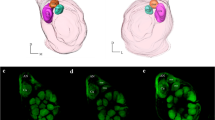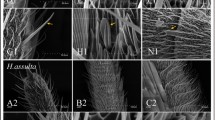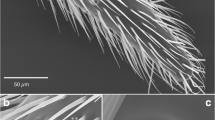Abstract
Partial electroantennograms (EAGs) and single cell recordings fromHeliothis virescens males have demonstrated the presence of pheromones receptor neurons in sensilla trichodea type 2 as well as in type 1. This is supported by cobalt tracing experiments, showing that primary axons from the distal flagellum, containing only s. trichodea type 2, project into the macrogiomerulus complex in the male antennal lobes. Four types of finely tuned pheromone receptor neurons were found in males, whereas in females the corresponding neurons responded mainly to host odors. In males the majority (75 and 18%, respectively) were tuned to the majorHeliothis virescens pheromone components (Z)-11-hexadecenal (Z11-16∶A1) and (Z)-9-tetradecenal (Z9-14∶A1). The others (5 and 2%, respectively) responded specifically to (Z)-1 1-hexadecen-1-ol (Z1 1-16∶OH) and (Z)-1 1-hexadecen-1-ol acetate (Z1 1-16∶Ac). No neurons responding selectively to the minor pheromone components were found. The Z11-16∶A1 neurons of both sensilla types possessed similar specificity. However, the sensitivity decreased toward the medial and distal part of the flagellum, where s. trichodea type 2 are located. This suggests that the pheromone concentrations can be detected peripherally by a spatial as well as a temporal mechanism. Differences in temporal response patterns (pronounced phasic vs. tonic component) were found within the same type of neurons, suggesting different ability to encode intermittency of the pheromone plume as well as to mediate maintenance of flight.
Similar content being viewed by others
References
Almaas, T.J., andMustaparta, H. 1990. Pheromone reception in tobacco budworm moth,Heliothis virescens.J. Chem. Ecol. 16:1331–1347.
Almaas, T.J.,Christensen, T.A., andMustaparta, H. 1990. Encoding of different features of an olfactory stimulus by the sex pheromone receptors inHeliothis zea (Lepidoptera: Noctuidae).J. Comp. Physiol. A. (Accepted)
Altman, J.S., andTyrer, N.M. 1980. Filling selected neurons with cobalt through cut axons, pp. 377–405,in N.J. Strausfeld, and T.A. Miller (eds.). Neuroanatomicai Techniques. Springer, Berlin. Springer Series in Experimental Entomology.
Bacon, J.P., andAltman, J.S. 1977. A silver intensification method for cobalt-filled neurons in wholemount preparations.Brain Res. 138:359–363.
Boeckh, J. 1962. Electrophysiologische Untersuchungen an einzelnen Geruchsrezeptoren auf den Antennen des Totengrabers (Necrophorus, Coleoptera).Z. Vergl. Physiol. 46:212–248.
Christensen, T.A., andHildebrand, J.G. 1987. Male-specific, sex-pheromone selective projection neurons in the antennal lobes of the mothManduca sexta.J. Comp. Physiol. A 160:553–569.
Christensen, T.A., Mustaparta, H., andHildebrand, J.G. 1989. Discrimination of sex pheromone blends in the olfactory system of the moth.Chem. Senses 14:463–477.
Heath, R.R., Mitchell, E.R., andTovar, J.C. 1990. Effect of release rate and ratio of (Z)-l 1-hexadecen-1-ol from synthetic pheromone blends on trap capture ofHeliothis subflexa (Lepidoptera: Noctuidae).J. Chem. Ecol. 16:1259–1268.
Kafka, W.A. 1970. Molekulare Wechselwirkung bei der Erregung einzelner Riechzellen. Z.Vergl. Physiol. 70:105–143.
Kaissling, K.-E. 1971. Insect olfaction, pp. 351–431,in L.M. Beidler (ed.). Chemical Senses Part 1. Olfaction. Handbook of Sensory Physiology, Vol. IV. Springer, Berlin.
Kaissling, K.-E. 1986. Chemo-electrical transduction in insect olfactory receptors.Annu. Rev. Neurosci. 9:121–145.
Masson, C., andMustaparta, H. 1990. Chemical information processing in the olfactory system of insects.Physiol. Rev. 70:199–245.
Meng, L.Z., Wu, C.H., Wicklein, M., Kaissling, K.-E., andBestmann, H.J. 1989. Number and sensitivity of three types of pheromone receptor cells inAntheraea pernyi andA. polyphemus.J. Comp. Physiol. A 165:139–146.
Mustaparta, H., Angst, M., andLanier, G.N. 1979. Specialization of olfactory cells to insectand host-produced volatiles in the bark beetleIps pini (Say).J. Chem. Ecol. 5:109–123.
Mustaparta, H., Angst, M., andLanier, G.N. 1980. Receptor discrimination of enantiomers of the aggregation pheromone ispdienol, in two species ofIps.J. Chem. Ecol. 6:689–701.
Obermayer, M., andStrausfeld, N.J. 1980. Silver-staining cobalt sulfide deposits within neurons of intact ganglia, pp. 406–430,in N.J. Strausfeld, and T.A. Miller, (eds.). Neuroanatomical Techniques. Springer Series in Experimental Entomology.
O'Connell, R.J., Grant, A.J., Mayer, M.S., andMankin, R.W. 1983. Morphological correlates of differences in pheromone sensitivity in insect sensilla.Science 220:1408–1410.
Raina, A.K., Stadelbacher, E.A., andRidgway, R.L. 1989. Comparison of sex pheromone composition and pheromone-mediated male behavior of laboratory-reared and wildHeliothis zea (Lepidoptera: Noctuidae).J. Chem. Ecol. 15:1259–1265.
Ramaswamy, S.B., Randle, S.A., andMa Wai Keung 1985. Field evaluation of the sex pheromone components ofHeliothis virescens (Lepidoptera: Noctuidae) in cone traps.Environ. Entomol. 14:293–296.
Roelofs, W.L., Hill, A.S., Cardé, R.T., andBaker, T.C. 1974. Two sex pheromone components of the tobacco budworm moth,Heliothis virescens.Life Sci. 14:1555–1562.
Rumbo, E.R., andKaissling, K.-E. 1989. Temporal resolution of odour pulses of three types of pheromone receptor cells inAntheraea polyphemus.J. Comp. Physiol. A 165:281–291.
Schneider, D. 1957. Elektrophysiologische Untersuchungen von Chemound Mechanorezeptoren der Antenne des SeidenspinnersBombyx mori L.Z. Vergl. Physiol. 40:8–41.
Teal, P.E.A., Tumlinson, J.H., andHeath, R.R. 1986. Chemical and behavioral analysis of volatile pheromone components released by callingHeliothis virescens (F) females (Lepidoptera: Noctuidae).J. Chem. Ecol. 12:107–126.
Tumlinson, J.H., Hendricks, P.E., Mitchell, E.R., Doolitle, R.E., andBrennan, M.M. 1975. Isolation, identification and synthesis of the sex pheromone of the tobacco budworm.J. Chem. Ecol. 1:203–214.
Author information
Authors and Affiliations
Rights and permissions
About this article
Cite this article
Almaas, T.J., Mustaparta, H. Heliothis virescens: Response characteristics of receptor neurons in Sensilla Trichodea type 1 and type 2. J Chem Ecol 17, 953–972 (1991). https://doi.org/10.1007/BF01395602
Received:
Accepted:
Issue Date:
DOI: https://doi.org/10.1007/BF01395602




